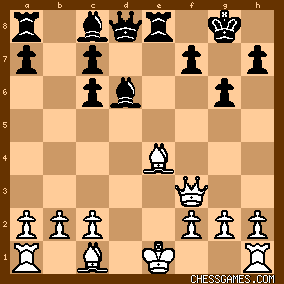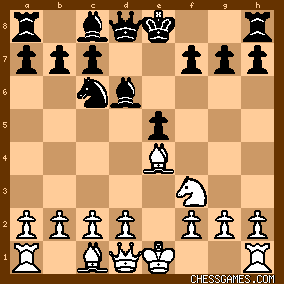| Feb-09-04 | | Whitehat1963: Tarrasch not at his best. |
|
| Feb-04-05 | | iron maiden: 24. fxe3 Qh2 wins both rooks due to the mating threat. Tarrasch was completely dominated here. |
|
| Jul-26-05 | | Ulhumbrus: It is interesting that 9 Nxc6 bxc6 10 0-0 gains the advantage, while 10 Be3 passes the advantage to Black. Can a reason be given for this? One is that the Nd4 is threatened on this square, and because of this so is its defender, the white queen. Thus a move which probably infringes Tarrasch's rules of development is correct. A matter worth comtemplating. |
|
| Jul-26-05 | | ughaibu: I guess you mean 10.Nc6 c6 11.00 which would lose a piece to Qh4. |
|
| Jul-29-05 | | Ulhumbrus: Ughaibu : I stand corrected. White gains the advantage by 10 Nxc6 bxc6 11 Be3, while refraining from exchanging the Nd4 for the Nc6 by 10 Be3 passes the advantage to Lasker. It seems that the principle of rapid development takes a beating in this game. A matter worth contemplating, as I say. If it is advisable to move the Nd4 a third time to exchange it for the Nc6 moved once, there exists probably a reason why. What is the reason? |
|
| Jul-29-05 | | Koster: <Ulhumbrus: Ughaibu : I stand corrected. White gains the advantage by 10 Nxc6 bxc6 11 Be3> Here 10..Qh4 is also strong 11.Qe2 Re8 12. Bxh7ch Kf8 13.Be3 bxc6 with initiative for black , or 11. Bf3 Re8ch 12.Be3? Rxe3ch. |
|
Nov-15-05
 | | LIFE Master AJ: An impressive win by Lasker, thanks to <Koster> for bringing this game to my attention. |
|
| Jan-08-06 | | sneaky pete: Better is 9.Bxc6+ bxc6 10.Qxd4 .. as in Tartakower vs Reti, 1920. Another possible improvement, suggested by Tartakower, is 12.Qd2 Rb8 13.0-0-0! c5 14.Nf3 Qa4 15.a3 .. "with a double-edged game". |
|
| Apr-13-06 | | MorphyMatt: Siegbert got thrown in the Tarrasch compactor! |
|
| Aug-27-08 | | dwavechess: 18/23 coincidences with rybka 2.3.2 at 14 ply forwards for lasker. Moves 19 and 22 looks bad for white |
|
| Sep-11-08 | | dwavechess: Identical for Rybka 3 w32 at 3 minutes per move. |
|
| Oct-08-09 | | Ulhumbrus: <sneaky pete> Perhaps Tarrasch's advantage in development is at least partly an illusion, because he has lost time by withdrawing his Bc4 to d4 and then moving it to e4. Tartakower may be right, but how about the following alternative to 10 Be3: 10 Qh5 before Black can play his own Queen to h4. On 10 Qh5 g6 11 Nxc6 gxh5 12 Bxd8 Rxd8 13 0-0 Black's King side is broken. On 10 Qh5 g6 11 Nxc6 bxc6 12 Qf3 Black cannot attack the B e4 in time to win it. |
|
| Oct-09-09 | | sneaky pete: <Ulhumbrus> After 10.Qh5 g6 11.Nxc6 bxc6 12.Qf3 Re8
click for larger viewI think white is lost. 13.0-0 Qh4 loses Be4 (14.Re1 Qxh2+ 15.Kf1 Ba6+ only makes it worse); 13.Kf1 Qe7 again loses Be4 and finally, if 13.Be3 Qh4 (pinning pawn f2)14.Bxc6 Bg4 or 14.Bd3 Bg4 also looks winning for black. From uncle pete's Words of Wisdom:
1) Pinning is winning.
2) Castle early and often. |
|
| Oct-09-09 | | Ulhumbrus: <sneaky pete> The threat of ...Re8 seems too strong. It looks as if White can't transform the bishop on e4 from a target into a weapon. |
|
| Nov-17-12 | | Wyatt Gwyon: Tarrasch is already in a bit of trouble by move four. |
|
Nov-17-12
 | | perfidious: <Wyatt Gwyon> The line beginning with 4....Nxe4 is a well-known equaliser and I had at least two serious games with it long ago, plus numerous blitz games. In a Boylston Chess Club championship, William Lukowiak played into the line featured in this game, and IIRC, we followed Tarrasch-Lasker at least as far as 9....0-0. |
|
Nov-18-12
 | | perfidious: <Wyatt Gwyon> See also the kibitzing on this page: J Heftye vs Mieses, 1902. My tired old brain just recalled all this. |
|
| Sep-26-14 | | dehanne: After 10.Nxc6 the immediate 10...Qh4 is good. |
|
Feb-21-18
 | | keypusher: 17.h3, which may have been Tarrasch's idea, runs into 17....Rxe3+. So he played 17.Rg1 instead. Lasker could have responded with 17....Qxh2, since 18.Rh1 runs into ...Rxe3+ again. After 21....Rbd8 the queen can't leave the central files, e.g. 22.Qb3 Qh2 23.Rf1 Bxg3. Just a massacre. White was in trouble after his very normal-looking 9th move. According to Soltis, 9....0-0! was first played by the internees at Triberg, but Lasker probably discovered their innovation independently. |
|
| Feb-21-18 | | whiteshark: Bc4 in the 4♘ is such a beginner's move (mistake) as shown by Lasker. My guess is that this is probably Lasker's preparation as Tarrasch had this position in game #152 in "Die moderne Schachpartie", a consultation game he played in Nuremberg 1912 against Herr Lindtröm and N.N. He (Dr. T.) wrote/thought that in his view <4.Nc3> is the most correct continuation in the Prussian game. |
|
Feb-21-18
 | | keypusher: <whiteshark: Bc4 in the 4♘ is such a beginner's move (mistake) as shown by Lasker.> Rather prescriptive of you, <whiteshark>. If Tartakower and Tarrasch both like 4.Nc3, maybe it's not so bad? http://www.chessgames.com/perl/ches... |
|
| Feb-21-18 | | whiteshark: <keypusher: Rather prescriptive of you, <whiteshark>.> Yes, you're right.
click for larger viewWhite to move
1) +0.05 (37 ply) 8.Qe2 O-O 9.O-O Nd4 10.Nxd4 exd4 11.Qd3 h6 12.b3 Re8 13.Bb2 Bxh2+ 14.Kxh2 Qh4+ 15.Kg1 Qxe4 16.Qxd4 Qxd4 17.Bxd4 Bf5 18.Rfe1 a5 19.Rxe8+ Rxe8 20.d3 f6 21.Bc3 b6 22.f3 Re2 23.Rc1 Bd7 24.Kf1 Re7 25.Bd2 a4 26.Kf2 Kf7 27.Bf4 axb3 28.cxb3 2) =0.00 (37 ply) 8.O-O O-O 9.Qe2 Nd4 10.Nxd4 exd4 11.Qd3 h6 12.b3 Re8 13.Bb2 Bxh2+ 14.Kxh2 Qh4+ 15.Kg1 Qxe4 16.Qxd4 f6 17.Rac1 Qxd4 18.Bxd4 a5 19.Rfe1 Bd7 20.a4 b5 21.Rxe8+ Bxe8 22.axb5 Bxb5 23.c4 Bd7 24.Ra1 Kf7 25.f3 a4 26.Bc5 Bc6 27.bxa4 Bxa4 28.Kf2 3) =0.00 (36 ply) 8.Bxc6+ bxc6 9.O-O O-O 10.Re1 Re8 11.d3 Qf6 12.Bd2 Qg6 13.Nh4 Qf6 14.Nf3 60.0 minute analysis by Stockfish 9 v010218 |
|
| Feb-21-18 | | heuristic: see olga for SF lines:
17.Rg1?
17.Qg2 Rab8 18.h3 Be6 19.g4 Qg6 20.Qe4
20.Qe2?
20.Rh1 Bxf1 21.Rxh5 Bxc4 22.Rxe5 Rxe5 23.b3 Be6 24.0-0-0 22.Nxe5?!
22.Kd2 Rxd3+ 23.cxd3 Bf6 24.Rge1 |
|
| Feb-15-21 | | SymphonicKnight: An instructive miniature in which Lasker teaches Tarrasch that Bc4 is undesirable in the Four Knights opening. An instructive alternative -- if instead of 17...Rab8, Lasker had played 17...Qxh2, 18.Rh1 does not trap the Q because of the pretty checkmate beginning with 18...Rxe3+!! Tarrasch did not show his best form in this game, but Lasker was very impressive, showing very deep understanding of these types of positions. |
|





